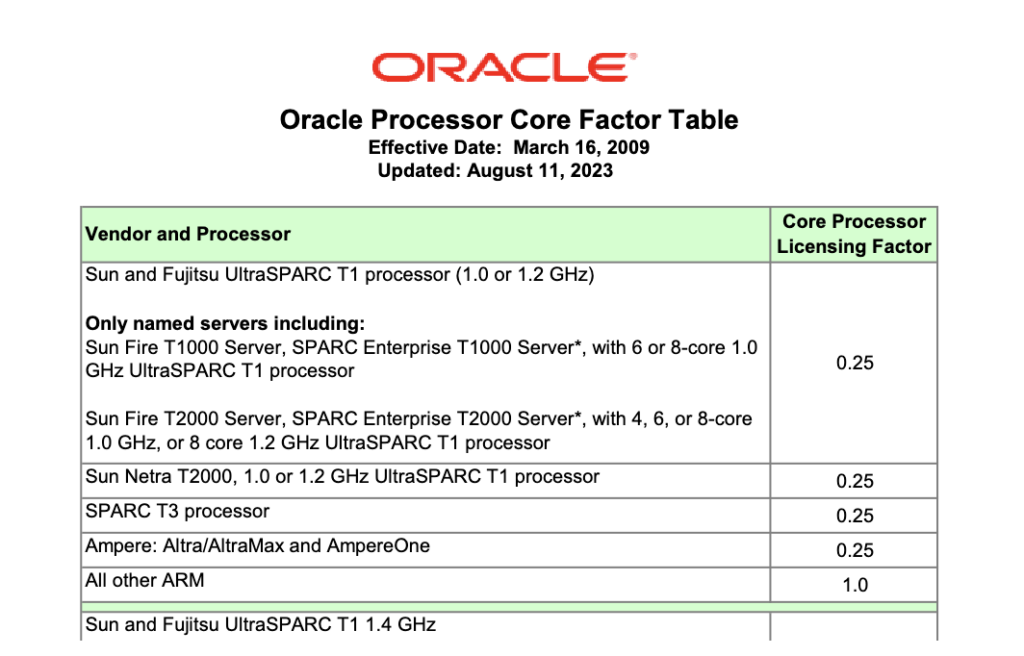In June of 2023 Oracle announced support for their database on ARM-based platforms. The significance of this is the fact that ARM architecture is making significant advancements in servers and data centers. ARM is no longer just for your Android phone or Raspberry Pi.
ARM processors, or Advanced RISC Machine, have been a common processor in cell phones and tablets for a long time now. The appeal of ARM in these types of devices is primarily reduced power requirements. Original RISC processors, like IBM Power and Sun SPARC, used a reduced number of instructions allowing for more efficient multi-core processing in servers. ARM processors use a similar reduction in CPU instructions with the added benefit of sipping power.
Lately, power hungry devices, like Mac Books from Apple, have adopted ARM-based processors, breaking the portable device barrier. Intel has been the leader in X86 computing for a long time. High end desktops and servers have predominantly used Intel-based processors due to their performance advantage over other X86 offerings. With ARM processers becoming more powerful and still having a significant power consumption advantage, it is no wonder that ARM-based servers are making advancements in the data center.
With this in mind, ARM based processors are becoming very popular with all of the public cloud providers. AWS, the industry leader in public cloud computing, released its Graviton processor a while ago. The Graviton 3, the current generation of Graviton processor, has made significant performance improvements. My initial thought was, that’s great but what can we run on this different architecture besides custom developed applications? Well, now that companies like Oracle are releasing their products for ARM this changes the public cloud landscape dramatically. Once a change like this gets some momentum it doesn’t take long to change the whole industry.
This blog is focused on Oracle database software on ARM. So, you know there are going to be licensing concerns. The obvious first question is what this new support for ARM processors does to the core factor table. The contractual core factor table was updated on August 11, 2023. There are two lines added for ARM processors.
| Processor Type | Core Factor |
| Ampere: Altra/AltraMax and AmpereOne | 0.25 |
| All other ARM | 1.0 |

It is obvious why the Ampere ARM processors require 1/4 of the licensing as all other ARM processors. Oracle Cloud Infrastructure (OCI) uses Ampere processors for their ARM implementations. This is well within Oracle’s purview to manipulate the licensing rules to their advantage. After all, they own the software. This change to the Core Factor Table will have a huge financial impact on AWS customers that want to migrate onto the cost-effective Graviton processor.
Licensing ARM in the Cloud
As stated earlier, hyperscaler public cloud providers are very interested in ARM-based servers. The power and cooling advantages that ARM provides will have a huge impact on the cloud providers over the course of the next few years. Three of the biggest public clouds have adopted the Ampere ARM processor for their ARM-based servers, Azure, Google Cloud Platform (GCP) and OCI. See the following links for more information.
All three of these public cloud providers have invested in Ampere’s cloud-native ARM processor offerings.
AWS has taken a different path. As with most of AWS’s recent processor offerings, the Graviton 3 is custom designed by AWS. The Graviton 3 is a 64-core processor. The .metal server offered by AWS supporting the Graviton 3 are listed as 64 vCPUs, which tells us that the servers are using a single Graviton 3 processor and the cores are not using any form of Simultaneous Multithreading (SMT). A vCPU on a Graviton 3 gets a whole core.
Oracle’s Cloud Licensing Policy
The Oracle Cloud Licensing Policy is a public facing document that provides Oracle customers with guidance on how to license Oracle workloads running in AWS and Azure by the vCPU, not physical hardware. While this policy document is non-contractual, Oracle does honor the policy as a legitimate way to count licenses running in an authorized cloud environment. This policy states:
“For the purposes of licensing Oracle programs in an Authorized Cloud Environment, customers are required to count the maximum available vCPUs of an instance type as follows:
- Amazon EC2 and RDS – count two vCPUs as equivalent to one Oracle Processor license if multi-threading of processor cores is enabled, and one vCPU as equivalent to one Oracle Processor license if multi-threading of processor cores is not enabled.
- Microsoft Azure – count two vCPUs as equivalent to one Oracle Processor license if multi-threading of processor cores is enabled, and one vCPU as equivalent to one Oracle Processor license if multi-threading of processor cores is not enabled.”
No ARM processors use SMT. This is by design. This means that one ARM vCPU in Azure or AWS requires one Oracle processor license.
GCP is not an Oracle Authorized Cloud, so running Oracle in GCP requires core-based licensing.
OCI is run by Oracle, so licensing for Oracle products running in OCI is negotiable.
Traditional Core-based Licensing
The default model for public cloud providers is the shared-tenancy model. If you create an EC2 instance on AWS, it is likely to land on a physical server that is shared by multiple AWS accounts. However, it is possible to deploy a dedicated host in the public cloud. When dedicated hosts are used, traditional Oracle core-based licensing can also be used, including the Oracle Core Factor table. This puts AWS in a bind related to licensing dedicated hosts for Graviton. The table below illustrates the predicament when using core-based licensing for Oracle with the Core Factor table.
| Cloud Provider | Host Type | Cores | Oracle Licenses |
| AWS | r7g | 64 | 64 |
| Azure | Dpsv5 | 64 | 16 |
| GCP | T2A | 48 | 12 |
At House of Brick, some of our larger customers employ dedicated hosts for their Oracle workloads. This can have a significant impact on their licensing costs. The change to the Core Factor table making ARM processors other than Ampere a 1:1 ratio for licensing makes dedicated hosts four times more expensive to run in AWS than in Azure or GCP.
Conclusion
We are on the verge of ARM-based processors gaining significant market share in the server market. The two giants in the ARM server processor space are AWS with their Graviton processor and Ampere with their Altra and AmpereOne processors. Fujitsu has an ARM-based server processor, but this processor is mainly used for HPC applications in super computers. Public cloud providers are already investing heavily in ARM-based servers due to power, cooling, and chip cost advantages. Oracle has ported its flagship database product to ARM making it possible to start thinking about migrations. As with any hardware move where Oracle is involved, the licensing costs must be considered. If not, then be prepared to pay more money.
In part two of this blog series, I will run through the steps to migrate an on-premises Oracle database running on X86 to the cloud running on ARM.








